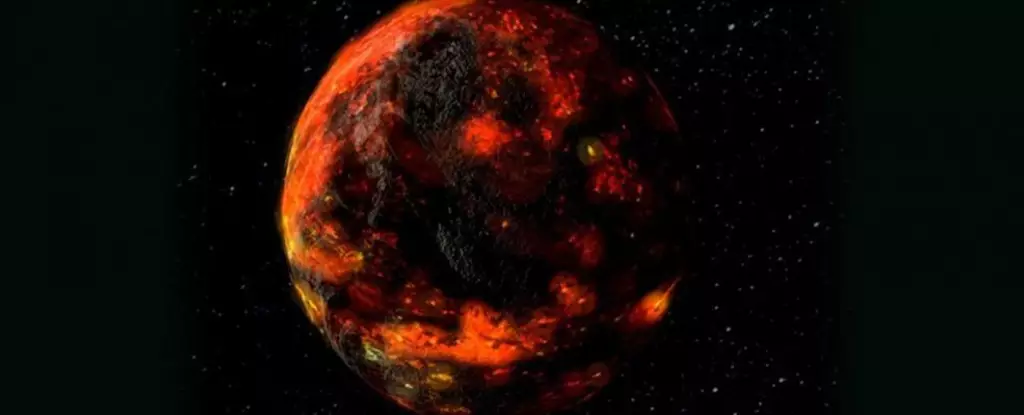The Moon, our closest celestial neighbor, has long captivated scientists and astronomers alike. Despite decades of research and exploration, many questions about its early history remain unanswered. Recent advancements in the analysis of Moon rocks collected during the Apollo missions have shed light on its formative years, revealing that it solidified around 4.43 billion years ago, a timeframe that intriguingly coincides with Earth’s development into a habitable environment. This article delves into the findings spearheaded by a team of researchers led by University of Chicago scientist Nicolas Dauphas, exploring the implications of these discoveries and their significance in understanding both the Moon’s history and the evolution of Earth.
The Birth of the Moon: Collision and Cooling
The genesis of the Moon is hypothesized to have stemmed from a cataclysmic collision between the young Earth and a Mars-sized protoplanet known as Theia. This colossal impact ejected a significant amount of molten debris into space, which ultimately coalesced to form the Moon. Initially, this newly formed satellite existed as a hot, liquid mass — a “big ball of magma,” as described by Dauphas. Following this tumultuous beginning, the Moon underwent a gradual process of cooling and solidification.
As the lunar surface began to set, it evolved into distinct layers, with the majority of its magma ocean (approximately 99%) crystallizing. This solidification didn’t occur uniformly. Instead, it resulted in the formation of a unique residual liquid known as KREEP, an acronym for potassium, rare earth elements, and phosphorus. Understanding the formation and distribution of KREEP is essential as it may hold crucial information regarding the Moon’s geological history and its relationship to other bodies in the Solar System.
Dauphas and his team focused their research on the KREEP material present in the lunar samples. By examining the ratios of various elements contained in these rocks, they deduced that KREEP formed roughly 140 million years after the Solar System came into existence, correlating with the solidification phase of the Moon. Specifically, they analyzed the decay of lutetium into hafnium, a process that acts as a geological clock.
In the early Solar System, all rocks shared a similar abundance of lutetium, which decays into hafnium over time. The researchers sought to compare the proportions of these elements in lunar samples with those from meteorites created during the same epoch. Their analysis indicated a clear connection between the ages of moon rocks and the KREEP reservoirs, solidifying their hypothesis regarding the Moon’s cooling timeline. This meticulous investigation required years of refining techniques, ultimately leading to a “very precise answer for a question that has been controversial for a long time,” as Dauphas articulated.
The Moon didn’t cool in a vacuum. During its formative epochs, it was bombarded by remnants from the early Solar System, including leftover planetary embryos and planetesimals, remnants from the chaotic formation of planets. This ongoing bombardment occurred while the Moon’s magma ocean was solidifying, further complicating its geological narrative.
Additionally, their research suggested that the KREEP reservoirs formed during a tumultuous time when the Moon was not only evolving but labored under constant cosmic impacts. Such events played a pivotal role in shaping the lunar surface, leading eventually to the development of mare basalts — expansive lava flows that resulted from significant impacts that occurred approximately 240 million years after the Solar System’s formation.
The Implications for Earth’s History
The findings of this study extend beyond the Moon’s geology; they also provide valuable insights into Earth’s evolution. The impact that formed the Moon may well be the last significant collision Earth experienced during its early formation. Understanding the timeline of the Moon’s development aids in piecing together the puzzle of Earth’s transformation into a stable planet capable of supporting life.
Dauphas highlighted the significance of these studies: “This finding aligns nicely with other evidence; it’s a great place to be in as we prepare for more knowledge about the Moon from the Chang’e and Artemis missions.” These upcoming missions are poised to enrich our understanding further, offering fresh samples and data that could fill in the remaining gaps regarding both lunar and terrestrial histories.
The research conducted by Dauphas and his colleagues not only elucidates the early history of the Moon but also sets the stage for future discoveries that will contribute to our overall understanding of the Solar System. As space exploration advances with missions targeting unexplored regions such as the South Pole-Aitken basin, scientists remain hopeful that new findings will unravel the complexities of the Moon’s early years and its profound interconnectedness with Earth. The ongoing pursuit of knowledge about our Moon promises to reshape our grasp of planetary formation, evolution, and the very nature of life beyond our home planet.

